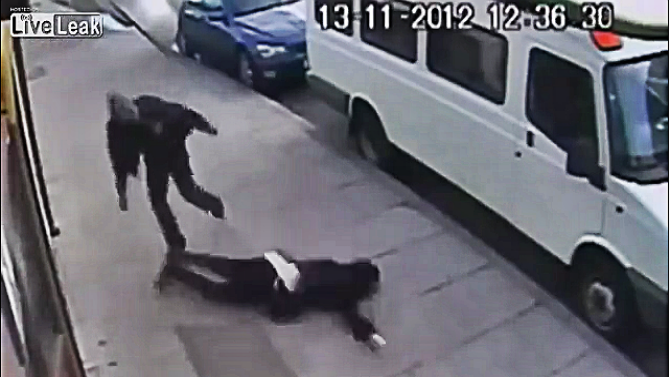Colin Liddell
Occidental Observer
November 25, 2013
The Knockout Game, as any fool knows, is an activity engaged in by groups of feral Black “youths” whereby they attempt to sucker punch a lone White. It is interesting to see the way that the mainstream media is now tentatively approaching the problem, perhaps spurred by the good work of people like Colin Flaherty, author of White Girl Bleed a Lot, who has done a lot to publicize the ‘game’ to people who haven’t had direct experience of it.
The point of the so-called game is to land a perfect, cartoon-like knockout punch on the victim. Whether or not the victim then hits the ground and dies seems to be of little concern to the high-fiving participants.
There have possibly been cases when other Blacks have been victims, so the mainstream media and establishment can go on pretending that there is no racial component to it. But there obviously is, and not just because Blacks are overwhelmingly attacking Whites in this manner.
The real racial dimension is actually much wider than most people suspect, because the Knockout Game is merely a product of a much more widespread phenomenon, namely the awkward way that Blacks and Whites relate to each other in public spaces in America and the simulated blindness that this encourages. The Knockout Game has sprouted into existence because there is a socio-environmental niche for it.
One of the characteristics of modern urban societies is the way that people politely or not so politely ignore each other. This habit of treating other people as if they are not there is essential to the smooth running of dense urban societies, simply because we don’t have time to treat everyone like a human being.
In well-run homogenous societies, like Japan, where there are high levels of mutual trust, ignoring others or turning your back on them is hardly a problem. You will often find Japanese people asleep on trains and in other public places in complete safety.
It is a different story in multiracial societies, especially those like America, where there is deep-seated animosity and smouldering distrust between the different racial groups. In general, American Blacks harbour resentment and feelings of animosity against Whites, who, in turn and quite sensibly, distrust Blacks.
Where such feelings exist, the natural response is for the antagonistic populations to separate out, and of course this has happened to a considerable degree in America, at the community level with self-segregation and White Flight.
At a street level, the correct natural response when confronted by a potentially dangerous group of young men from a different racial group is to be extremely wary. This should involve such actions as bracing oneself, readying a weapon — concealed or not — for self-defence, and maintaining as much distance as is possible by circling around the group, crossing to the other side of the street, or doing a U-turn.
The problem, however, is that American society is striving quite unnaturally to maintain a myth of racial harmony. This means that any of the above actions would be considered inflammatory and the victims know this.
The only thing for a White to do in such cases is to pretend that nothing is wrong and walk past such groups as if they were all members of the same racial and ethnic trust group. In fact, to counter feelings of fear and discomfort that naturally arise on such occasions, special efforts are made to mask any obvious fear and to appear nonchalant and unconcerned.
The methods used to achieve this include looking at a spot in the distance, staring at the ground, giving an insincere or nervous smile, and, most importantly, simulating trust by showing a lack of positional awareness.
This effort has three consequences. First, he will appear to the group of Blacks to be acting in a forced and unnatural way, which they will construe, quite rightly, as motivated by a sense of racial difference and distrust. Second, he will allow the Blacks to get within punching distance; and third, he will present his blind side to some of the group members, making him an easy target for a sudden punch.
One of the media myths quickly developing about the Knockout Game is that the victims are almost always unsuspecting. Although that may be possible in some cases, it seems likelier that most of the victims are actually intensely aware they are in a dangerous situation but have few options except to “act cool,” open up, and hope for the best.
In the name of the great post-racial myth, American society has been creating countless opportunities for such incidents every day. Look around you in any racially mixed setting, and you will see the telltale body language of the racially aware White playing his own game of racial blindness, a blindness that in other situations has given birth to the Knockout Game.

